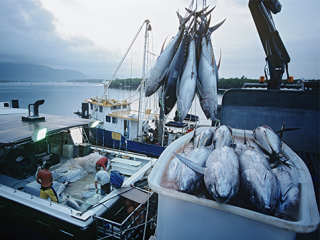
Posted by Richard Neves and Iris Claus[1]
In 2015 2.7 million tonnes of tuna (a catch valued at around USD 2.2 billion) were caught in the largest tuna fishery in the world (the Western Pacific fishery), accounting for around 57 per cent of the global catch. The 1.8 million tonnes of Skipjack tuna (the smallest and most abundant of the major commercial tuna) species represented around 67 per cent of the catch and were caught mostly by “purse seining”, namely the use of a large net to catch schools of fish.
Skipjack tuna are not considered an endangered species. They end up mostly as canned tuna which is consumed globally. The Western and Central Pacific Fisheries Commission (WCPFC) scientific committee recently outlined that the stock of skipjack tuna in the Pacific is moderately exploited, fishing mortality levels are sustainable, and the spawning biomass can be maintained near the target reference point of fifty per cent (basically, the combined weight of all the fish stock that are able to reproduce).
The exclusive economic zones (EEZs) of several Pacific countries, most of which are small island states, occupy a significant part of the fishery where the fish are caught (Cook Islands, Federated States of Micronesia, Palau, Papua New Guinea, Kiribati, Marshall Islands, Nauru, Solomon Islands, Tokelau, and Tuvalu). Most recently, Pacific countries have made significant steps towards maximizing their share of the incomes which are generated from the fishery. In 2008, government revenues, which predominantly consisted of access fees and license charges, represented six per cent of the value of the catch. A more unified approach towards negotiating access right fees to their waters by several Pacific countries saw government revenues rising to 22 per cent of the value of the catch in 2015.
Providing ecological sustainability into the future is crucial to ensuring that Pacific countries can continue to receive fishing revenues on an ongoing basis, noting that the Western Pacific fishery is considered one of the best managed in the world. The increased revenue from a “renewable” natural resource, however, presents challenges for policy makers in the Pacific. A recent workshop facilitated by PFTAC, with the support of the Asian Development Bank, brought together participants from marine ministries, central banks and ministries of finance from within the region to discuss these issues.
Forecasting fishing revenue—which involves estimating the revenue a country may receive from access fees through two variables, price and the number of vessel days sold—has proved difficult. Whilst a total allowable effort of around 45,000 days is established for the whole fishery, the allocation amongst the countries is less predictable because oceanic and climatic conditions can significantly alter in which EEZ the fish will swim. During an El Niño, better fishing conditions are experienced in the East, and the opposite during a La Niña.
Understanding what vessels from distant fishing nations will pay for access is also difficult. Whilst there is a benchmark minimum of USD 8,000 per day, prices in recent years have well exceeded this figure. There is currently no market for tuna futures. To provide general insights on forecasting annual tuna prices, studies by the IMF’s Research Department suggest that the price elasticities relative to GDP tend be positive, and thus that rapid global growth should translate into higher prices of tuna. This research also indicates that markets are quite integrated, as the income elasticities are positive and larger for the world regressions than the country-level regressions. Further, prices and global quantities tend to be positively correlated, suggesting that developments in other fish and food substitute markets are having a strong influence on tuna markets.
Another key issue is how to manage revenues from tuna sales. These are not windfall revenues, they are here to stay, at least over the medium term. In 2008, estimated revenues of USD 138 million were received by the Pacific Island governments. Seven years later, that figure had grown by over three and a half times to an estimated USD 500 million.
Fishing revenues have provided welcome breathing space for several countries who were encountering fiscal difficulties. The need now is to convert this breathing space into a more sustainable budget scenario moving forward. The first step for many nations is to recognize these are not temporary windfall revenues, but an ongoing feature of their own-source income, which may demonstrate volatility.
The Pacific Island countries can be extremely proud of what they have achieved. They are now a lot closer to receiving fair value from the valuable fishing resources which reside in their EEZs. The countries should develop medium-term fiscal frameworks to ensure that they can budget at an appropriate level, while managing the inherent volatility of fishing revenues. This transition will not be easy, but it must be done if these resources are to benefit the Pacific Island communities.
Access to the presentations of the workshop can be found at www.pftac.org
[1] Richard Neves is the PFM Advisor and Iris Claus is the Macroeconomic Advisor in the IMF’s Regional Technical Assistance Center for the Pacific Islands (PFTAC).
Note: The posts on the IMF PFM Blog should not be reported as representing the views of the IMF. The views expressed are those of the authors and do not necessarily represent those of the IMF or IMF policy.







